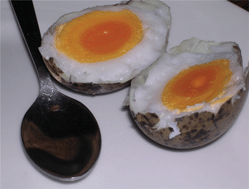A wide range and occasionally high levels of persistent organic pollutants (POPs) are reported in Arctic regions, especially among top predators. Polar bears (Ursus maritimus), arctic foxes (Alopex lagopus) and some gull species (Larus spp.) often have high levels of these fat-soluble pollutants. Gulls deposit significant levels of these contaminants in their eggs. In northern regions, gull eggs are part of the traditional human diet. In the present study we have investigated the levels of POPs in gull eggs in order to determine the tolerable weekly intake (TWI) for humans. Concentrations of polychlorinated biphenyls (PCBs), polychlorinated dibenzo-p-dioxins (PCDDs) and polychlorinated dibenzofurans (PCDFs) were measured in 214 gull eggs collected in the spring of 2001–02. The eggs were collected from four gull species (herring gulls (Larus argentatus), great black-backed gulls (L. marinus), lesser black-backed gulls (L. fuscus) and glaucous gulls (L. hyperboreus)) at 12 different locations in Northern Norway, on the Faroe Islands and on Svalbard. The pollutant levels in gull eggs were found to be 65.5 ± 26.9 pg toxic equivalent (TE) for dioxin and PCB g−1 wet weight. Based on these findings and the TWI-value determined by the EU Scientific Committee on Food it is advised that children, young women and pregnant and nursing women should not eat gull eggs. Other people should limit their intake of eggs to an absolute minimum, considering the health risks associated with gull egg intake.

You have access to this article
 Please wait while we load your content...
Something went wrong. Try again?
Please wait while we load your content...
Something went wrong. Try again?


 Please wait while we load your content...
Please wait while we load your content...